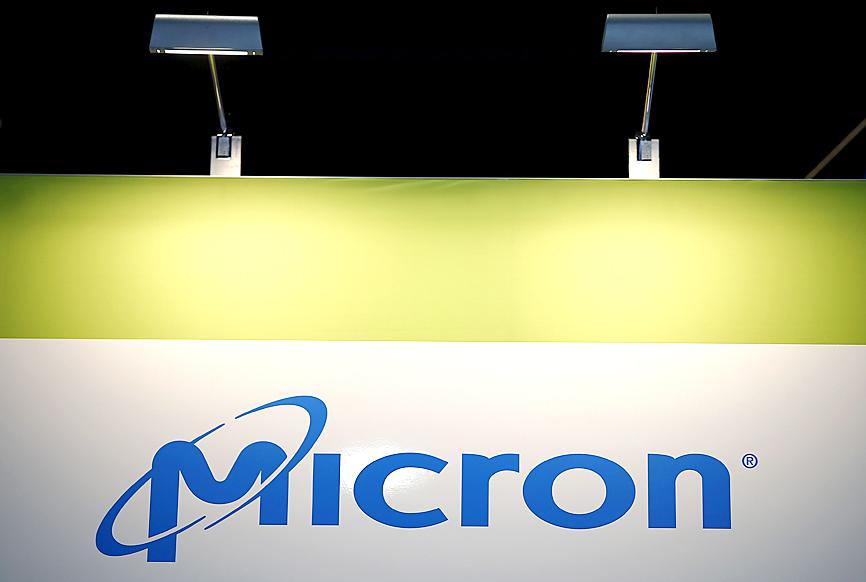United Microelectronics Corp (UMC, 聯電) and Micron Technology Inc yesterday said they have settled a civil lawsuit in which the US memorychip maker accused the Taiwanese company of stealing and leaking its intellectual property to a Chinese partner.
UMC is to make a one-time payment of an undisclosed amount to settle all competing claims between the companies globally, a joint statement said.
UMC said that it did not expect the payment to have any significant impact on its financial status.

Photo: Reuters
The move ends a high-profile chapter in tensions between the US and China, with the international case serving as a focal point for Washington complaints of Beijing facilitating forced technology transfers, a charge that China denies.
The case concerned an allegedly illegal transfer of Micron’s memory designs in a chip manufacturing deal between UMC and Jinjiang-based Fujian Jinhua Integrated Circuit Co (福建晉華).
Following the move, Micron said that it would continue to seek “full restitution” from UMC in a separate civil lawsuit, the statement said.
Last year, UMC pleaded guilty in San Francisco federal court in a deal with US prosecutors, who agreed to drop charges of economic espionage and conspiracy.
UMC instead admitted to trade-secret theft and agreed to pay a US$60 million fine.
Evidence submitted in connection with the guilty plea showed that the three workers — Steven Chen (陳正坤), Ho Chien-ting (何建廷) and Wang Yung-ming (王永銘) — were employed at Micron Taiwan before joining UMC.
Chen, who had been president at Micron Taiwan and was made senior vice president at UMC, brokered a deal with Fujian Jinhua to develop DRAM technology for the Chinese firm.
The US Department of Justice in 2018 formally charged UMC and Fujian Jinhua, as well as Chen, Ho and Wang, with crimes related to conspiracy to steal, convey and possess stolen trade secrets from a US firm.

UNCERTAINTY: Investors remain worried that trade negotiations with Washington could go poorly, given Trump’s inconsistency on tariffs in his second term, experts said The consumer confidence index this month fell for a ninth consecutive month to its lowest level in 13 months, as global trade uncertainties and tariff risks cloud Taiwan’s economic outlook, a survey released yesterday by National Central University found. The biggest decline came from the timing for stock investments, which plunged 11.82 points to 26.82, underscoring bleak investor confidence, it said. “Although the TAIEX reclaimed the 21,000-point mark after the US and China agreed to bury the hatchet for 90 days, investors remain worried that the situation would turn sour later,” said Dachrahn Wu (吳大任), director of the university’s Research Center for

Alchip Technologies Ltd (世芯), an application-specific integrated circuit (ASIC) designer specializing in artificial-intelligence (AI) chips, yesterday said that small-volume production of 3-nanometer (nm) chips for a key customer is on track to start by the end of this year, dismissing speculation about delays in producing advanced chips. As Alchip is transitioning from 7-nanometer and 5-nanometer process technology to 3 nanometers, investors and shareholders have been closely monitoring whether the company is navigating through such transition smoothly. “We are proceeding well in [building] this generation [of chips]. It appears to me that no revision will be required. We have achieved success in designing

PROJECTION: KGI Financial said that based on its foreign exchange exposure, a NT$0.1 increase in the New Taiwan dollar would negatively impact it by about NT$1.7 billion KGI Financial Holding Co (凱基金控) yesterday said its life insurance arm has increased hedging and adopted other moves to curb the impact of the local currency’s appreciation on its profitability. “It is difficult to accurately depict the hedging costs, which might vary from 7 percent to 40 percent in a single day,” KGI Life Insurance Co (凱基人壽) told an investors’ conference in Taipei. KGI Life, which underpinned 66 percent of the group’s total net income last year, has elevated hedging to 55 to 60 percent, while using a basket of currencies to manage currency volatility, the insurer said. As different

Taiwanese insurers are facing difficult questions about the damage of recent swings in the New Taiwan dollar. Regulators might have a partial solution: letting firms change how they calculate the value of foreign currency assets. The Financial Supervisory Commission (FSC) is considering allowing insurers to use six-month average exchange rates when they calculate risk-based capital in their semiannual reports, a shift from the current system where insurers use exchange rates on the final day of reporting. The change could ease pressure on the US$1.2 trillion insurance sector, whose huge exposure to foreign assets came into the spotlight earlier this month after a